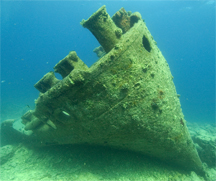|
You
are here: /main/research
expeditions/May 2005/Day 2 Midway
Atoll
Midway
Atoll, Day 2
by Kelly Gleason, Maritime Archaeology Team

USS Macaw. Photo by Robert
Schwemmer
Our
second day at Midway started off slowly since the morning
was reserved for much needed R&R time for the crew of
the Hi’ialakai. On a daily basis I try to describe the
long hours that the scientists are putting in, but these probably
pale in comparison to the long, rigorous hours that the crew
of the ship puts in to keep this operation running smoothly.
We are all extremely grateful for their hard work, and realize
that we couldn’t accomplish our goals without them.
Midway
is a strange and fascinating place. One of the questions that
I had at dinnertime for a couple of the other scientists was
whether the history of human activities on this island influences
their studies using the Northwestern Hawaiian Islands as a
place of low human impact to compare to other geographical
regions. Despite military occupation until the late 1990’s
and a failed attempts at ecotourism shortly following, Midway
Atoll is still a relatively undisturbed location. The coral
team noticed lots of healthy Montipora capitata (rice
coral) as they continued to set another permanent transect
today. Their work took place at two sites. One was at a permanent
transect that they placed today, and the other was at a permanent
transect previously established by Jim Maragos (USFWS). Jim
Maragos and Greta Aeby are collaborating with their work on
coral reef sites in the Northwestern Hawaiian Islands. While
Greta is an ecologist specifically studying coral disease,
Jim is a species identification expert and together they are
able to present a more complete picture of coral health in
the Northwestern Hawaiian Islands. Noticing so many healthy
corals today was interesting for the coral team, especially
following the heavy incidence of bleaching at Pearl and Hermes
Atoll and French Frigate Shoals. Usually, the northern three
atolls (Pearl and Hermes, Midway and Kure) are most susceptible
to bleaching. When Greta returns to these sites in September,
she will be able to compare their health at that time, when
the weather and water are warmer. It is more likely to see
coral bleaching later in the summertime, and the establishment
of permanent transects is the perfect way to understand these
events.
The
fish team headed out to tag more sharks and jacks and collect
more samples for Brian Bowen’s connectivity project.
Yannis, Carl, Randy, Harvey along with today’s addition
to the Magnificent 5, Jason Kehn, tagged three Galapagos Sharks
and three Ulua. Yannis also successfully placed one transceiver
at a spot in Midway. At the site of their first dive, the
fish team was fortunate enough to see a giant grouper. Yannis
estimated its size to be “almost as big as me!”
Spotting an enormous grouper is rare even in these waters.
The fish team took their second dive near the pier where we
are docked, since particular species tend to congregate nearby
structures such as piers and shipwrecks.
We
have another day of field operations at Midway tomorrow before
we continue on to Kure Atoll. As with all of our other sites
on this cruise, days in the field do not cease to amaze and
inspire us. Midway, as different as its history has been from
other atolls in this chain, is as intriguing and important
for the scientists as all the others.
|